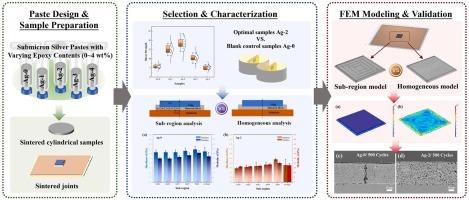用于电力电子可靠性预测的溶剂改性烧结银接头的细化分区域纳米压痕和FEM建模
IF 7.9
2区 材料科学
Q1 MATERIALS SCIENCE, MULTIDISCIPLINARY
引用次数: 0
摘要
广泛用于电力电子封装的烧结银接头的机械可靠性对于电动汽车转换器等长期应用至关重要。然而,传统的均匀建模往往过度简化了内部微观结构的变化,限制了应力预测的准确性,特别是在热循环下。在这项研究中,提出了一个区域细化的建模框架,以考虑环氧树脂调节的孔隙率和整个接缝的力学不均匀性。无压模贴接头是用亚微米银糊制备的,其环氧树脂含量不同(0 ~ 4 wt%)。将关节从中心到圆角划分为5个子区域进行局部表征。通过纳米压痕、扫描电镜和能谱分析来评估区域特定的力学性能和微观结构。提取每个区域的幂律本构模型,并将其应用于热循环(−55 ~ 150°C, 2个循环/h, 250 h)的有限元模拟中。与传统的均匀模型相比,分区域有限元模型更准确地捕获了局部应力集中,并确定了容易发生破坏的区域,特别是在圆角附近。实验验证证实了模拟应力区与观察到的退化之间的良好相关性。该子区域策略为高性能、大面积封装应用中烧结银接头的可靠性预测和设计优化提供了一个强大的框架。本文章由计算机程序翻译,如有差异,请以英文原文为准。

Refined sub-region nanoindentation and FEM modeling of solvent-modified sintered silver joints for enhanced reliability prediction in power electronics
The mechanical reliability of sintered silver joints, widely used in power electronics packaging, is critical for long-term applications such as electric vehicle converters. However, conventional homogeneous modeling often oversimplifies internal microstructural variations and limits the accuracy of stress prediction, especially under thermal cycling. In this study, a region-refined modeling framework is proposed to account for epoxy-regulated porosity and mechanical inhomogeneity across the joint. Pressureless die-attach joints were prepared using submicron silver pastes with varying epoxy contents (0∼4 wt%). The joint was divided into five sub-regions from the center to the fillet for localized characterization. Nanoindentation, SEM, and EDS analyses were conducted to assess region-specific mechanical properties and microstructure. Power-law constitutive models were extracted for each region and implemented into finite element simulations of thermal cycling (−55 ∼ 150 °C, 2 cycles/h, 250 h). The sub-region FEM model more accurately captured local stress concentrations and identified failure-prone areas, particularly near the fillet, compared to conventional homogeneous models. Experimental validation confirmed a good correlation between simulated stress zones and observed degradation. This sub-region strategy provides a robust framework for reliability prediction and design optimization of sintered silver joints in high-performance, large-area packaging applications.
求助全文
通过发布文献求助,成功后即可免费获取论文全文。
去求助
来源期刊

Materials & Design
Engineering-Mechanical Engineering
CiteScore
14.30
自引率
7.10%
发文量
1028
审稿时长
85 days
期刊介绍:
Materials and Design is a multi-disciplinary journal that publishes original research reports, review articles, and express communications. The journal focuses on studying the structure and properties of inorganic and organic materials, advancements in synthesis, processing, characterization, and testing, the design of materials and engineering systems, and their applications in technology. It aims to bring together various aspects of materials science, engineering, physics, and chemistry.
The journal explores themes ranging from materials to design and aims to reveal the connections between natural and artificial materials, as well as experiment and modeling. Manuscripts submitted to Materials and Design should contain elements of discovery and surprise, as they often contribute new insights into the architecture and function of matter.
 求助内容:
求助内容: 应助结果提醒方式:
应助结果提醒方式:


